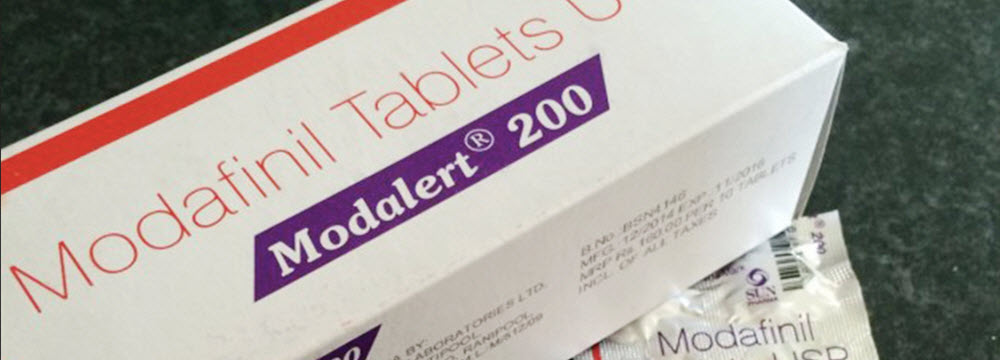
Modafinil is an eugeroic prescribed for the treatment of sleep disorders such as narcolepsy, shift work sleep disorder, and excessive daytime sleepiness due to sleep apnea.
Modafinil is a selective and relatively weak atypical dopamine reuptake inhibitor, but studies indicate that other mechanisms are at play as well.
Modafinil’s efficacy in improving vigor and well-being in sleep deprivation subjects is dependent on catechol-O-methyl transferase (COMT) status. Studies indicate that a great improvement in cognitive function is experienced by individuals with the Val/Val genotype. For test subjects with the Met/Met allele, there is very little improvement in cognitive function.
Modafinil as a cognition enhancer
Modafinil is widely used (off-label) as a cognition-enhancing agent in healthy non-sleep-deprived subjects. Research has confirmed that modafinil improves certain aspects of working memory, including digit manipulation and pattern recognition memory. Some of the cognition-enhancing effects of modafinil are only noticeable in individuals classified as lower-performing.
In a study1 published in 2013, researchers state that the “neurochemical effects [of modafinil] and anatomical pattern of brain area activation differ from typical psychostimulants and are consistent with its beneficial effects on cognitive performance processes such as attention, learning, and memory”.
Suggested reading
- Baranski JV, Pigeau R, Dinich P, Jacobs I (Jul 2004). “Effects of modafinil on cognitive and meta-cognitive performance”. Human Psychopharmacology. 19 (5): 323–32
- Battleday RM, Brem AK (2015). “Modafinil for cognitive neuroenhancement in healthy non-sleep-deprived subjects: A systematic review”. European Neuropsychopharmacology : the Journal of the European College of Neuropsychopharmacology. 25 (11): 1865–81
- Ghahremani DG, Tabibnia G, Monterosso J, Hellemann G, Poldrack RA, London ED (Apr 2011). “Effect of modafinil on learning and task-related brain activity in methamphetamine-dependent and healthy individuals”. Neuropsychopharmacology. 36 (5): 950–9
- Randall DC, Viswanath A, Bharania P, Elsabagh SM, Hartley DE, Shneerson JM, File SE (Apr 2005). “Does modafinil enhance cognitive performance in young volunteers who are not sleep-deprived?”. Journal of Clinical Psychopharmacology. 25 (2): 175–9.
- Turner DC, Robbins TW, Clark L, Aron AR, Dowson J, Sahakian BJ (Jan 2003). “Cognitive enhancing effects of modafinil in healthy volunteers”. Psychopharmacology. 165 (3): 260–9
- Minzenberg MJ, Carter CS (2008). “Modafinil: a review of neurochemical actions and effects on cognition”. Neuropsychopharmacology. 33 (7): 1477–502
- Müller U, Steffenhagen N, Regenthal R, Bublak P (Dec 2004). “Effects of modafinil on working memory processes in humans”. Psychopharmacology. 177 (1-2): 161–9
- Randall DC, Shneerson JM, File SE (Sep 2005). “Cognitive effects of modafinil in student volunteers may depend on IQ”. Pharmacology, Biochemistry, and Behavior. 82 (1): 133–9
Off-label use for fatigue
Modafinil is sometimes prescribed for off-label use against fatigue associated with multiple sclerosis, fibromyalgia, depression, myotinic dystrophy, chronic fatigue syndrome, primary biliary cirrhosis, spastic cerebral palsy, Parkinson’s disease, and opioid-induced sleepiness.
In the United States military, modafinil is approved for use on certain Air Force missions and it is currently being investigated for other uses.
Modafinil is available to astronauts on the International Space Station, to optimize their performance while fatigued and help with the reduced quality of sleep commonly experienced by astronauts.
Short facts about Modafinil
| Examples of trade names |
|
| Routes of administration |
|
| Pregnancy category |
|
| Legal status |
|
| Formula |
|
Pharmacodynamics
Dopamine transporter blocker
Modafinil impacts the dopamine transporter (DAT) and acts as a dopamine reuptake inhibitor (DRI) with an IC 50 value of 4 μM. It is a very weak, but also very selective, DAT inhibitor. Modafinil binds to the same site on the DAT as cocaine, but not in the same manner as cocaine. Modafinil increases locomotor activity and extracellular dopamine concentrations a manner similar to the selective DRI vanoxerine (GBR-12909). Also, Modafinil inhibits methamphetamine-induced dopamine release.
Modafinil is an atypical DAT inhibitor and produces effects that are very different from those produced by typical dopaminergic stimulants.
Modafinil elevates histamine levels in the hypothalamus. A study2 published in 2008 found that increased locomotor activity caused by modafinil depended on histamine release and could be abolished by depletion of neuronal histamine. This makes modafinil very different from methylphenidate.
DAT-independent actions
Modafinil’s ability to act as an dopamine reuptake inhibitor (DRI) is probably not the only reason for its wakefulness promoting effects. Even though modafinil acts as a dopamine reuptake inhibitor (DRI), tyrosine hydroxylase inhibitors are not capable of blocking the effects of modafinil. This is surprising, since tyrosine hydroxylase inhibitors are known to deplete dopamine. Also, modafinil is not capable of reversing reserpine-induced akinesia. (The dopamine-releasing agent dextroamphetamine is capable of reversing reserpine-induced akinesia.)
In 2012, a study3 was published where the DAT inhibition of modafinil was found to not correlate with its wakefulness-promoting effects.
1 Mereu, Maddalena; Bonci, Antonello; Newman, Amy Hauck; Tanda, Gianluigi (2013). “The neurobiology of modafinil as an enhancer of cognitive performance and a potential treatment for substance use disorders”. Psychopharmacology. 229 (3): 415–434
2 Ishizuka, Tomoko; Murakami, Masahiro; Yamatodani, Atsushi (2008). “Involvement of central histaminergic systems in modafinil-induced but not methylphenidate-induced increases in locomotor activity in rats”. European Journal of Pharmacology. 578 (2-3): 209–215
3Dunn, Derek; Hostetler, Greg; Iqbal, Mohamed; Marcy, Val R.; Lin, Yin Guo; Jones, Bruce; Aimone, Lisa D.; Gruner, John; Ator, Mark A.; Bacon, Edward R.; Chatterjee, Sankar (2012). “Wake promoting agents: Search for next generation modafinil, lessons learned: Part III”. Bioorganic & Medicinal Chemistry Letters. 22 (11): 3751–3753

